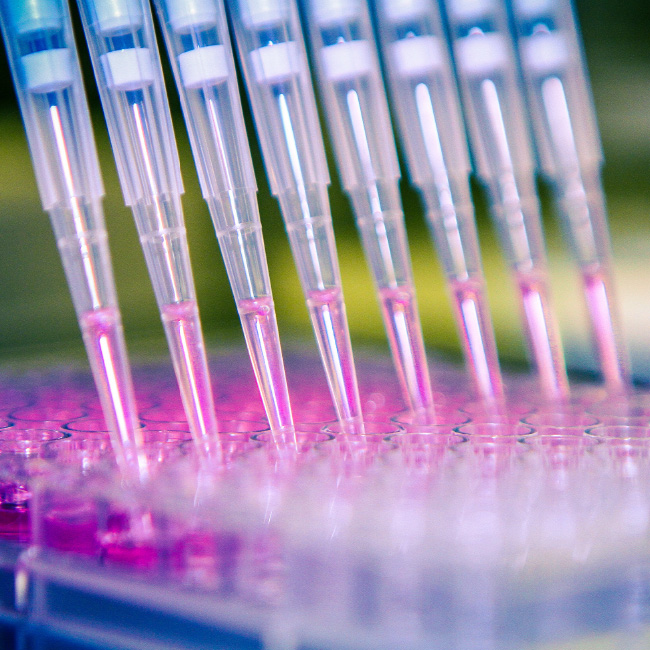An Integrated Diagnosis
An integrated diagnosis combines information about the tumor’s histopathology (how it looks under the microscope), grade (the tumor’s likely behavior and aggressiveness), and biomarkers.
Examining the tumor under a microscope provides doctors with a good idea of what the tumor is, but it has its limitations. For example, two brain tumors can appear to be the same tumor type under a microscope to even a trained medical professional’s eye, yet they can actually be different tumor types when examined at a molecular level. Similarly, some brain tumors can initially appear low-grade, but may, in reality, be a high-grade tumor, misleadingly presenting as less aggressive than they actually are.
So, how can the presence of a specific biomarker impact a brain tumor diagnosis?
- Example #1: Glioblastoma and grade 4 astrocytoma appear similar under a microscope. When analyzed at the molecular level, tumors with a mutation to a gene called “IDH1” or “IDH2” are classified as grade 4 astrocytoma, while tumors without an IDH mutation (“IDH-wildtype” tumors) are classified as glioblastoma.
- Example #2: IDH-mutant adult diffuse astrocytomas – which could be grades 2-4 – that test positive for a biomarker known as a “CDKN2A/B homozygous deletion” will automatically be labeled grade 4, regardless of their appearance under the microscope.
- Example #3: Gliomas with only lower-grade histologic (microscopic) features can be upgraded to grade 4 glioblastoma when looking at the tumor tissue’s molecular profile with biomarker testing.
Prognosis
Some biomarkers are considered prognostic because they provide insight into how a disease may progress, regardless of treatment. For example, IDH mutations are a prognostic biomarker because gliomas with an IDH mutation tend to be less aggressive than gliomas without an IDH mutation (also called IDH-wildtype).
Other biomarkers are considered predictive because they indicate how well the tumor will respond to a particular treatment. For example, a commonly run test is the MGMT promoter methylation test. This testing provides the tumor’s MGMT status, which helps doctors predict how well a patient may respond to temozolomide, the standard chemotherapy for glioblastoma.
By knowing your tumor’s biomarkers, doctors can give you an informed prognosis — a prediction or expected development of how a disease will progress.
“The biomarker testing gave us clarity that [histo]pathology alone couldn’t,” said Julia C. “The testing also allowed my health care team to give me a more accurate prognosis for the future, by understanding the genetic features of the tumor itself, and how they typically behave with those characteristics.”
Treatment Plan
More importantly, the information you receive from biomarker testing will help guide your treatment plan and potential access to clinical trials.
“Statistically, if you have glioblastoma, which is WHO grade 4, it’s going to be approached with a totally different set of treatments and a different set of decision points [than someone with low-grade meningioma] that the patient and their treating physician may need to make and decide together,” said Keith Ligon, MD, PhD, Chief of Neuropathology at Brigham and Women’s Hospital and Dana-Farber Cancer Institute (DFCI).
“Sometimes, there are different subtypes of tumors, perhaps based on mutations in glioblastoma, where new treatments open up as options through, say, a clinical trial,” Dr. Ligon continued. “Each of those affects decision-making, so it’s a tiered level of decisions and algorithms for what is appropriate for treating patients as far as our best understanding of how similar patients responded in the past.”
Clinical Trials
A tumor’s molecular and genetic makeup may open up an opportunity for a cutting-edge clinical trial or expanded access protocol. Conversely, it could save a patient from enrolling in a trial that is less likely to work for their precise tumor type, as defined by the integrated diagnosis.
“MGMT status is a routine part of the workup for most clinical trials,” said Craig Horbinski, MD, PhD, Director of Neuropathology at Northwestern Medicine. “At the very least, what they’re going to try to do is, on a statistical basis, randomize so that equal numbers of methylated and non-methylated [or unmethylated] patients are present in the treated group and the placebo control group because they don’t want that MGMT methylation status to become a confounding variable.”
All of this can make a real difference in treatment outcomes and ensure adherence to the latest medical guidelines.
2. Familiarize Yourself with the WHO Classification of Brain and CNS Tumors
The World Health Organization (WHO) Classification of tumors of the brain and central nervous system (CNS) is a standardized tool used in the diagnostic workup of a tumor. It organizes brain tumors into groups based on the structure of the tumor under a microscope and the molecular and genetic characteristics of the tumor. This classification system gets updated every few years, reflecting advancements in research. In 2021, significant changes were made to the classification of brain tumors, most notably, the increased importance of molecular and genetic information in defining a tumor.
Key Questions to Ask: Has my tumor been diagnosed according to the updated WHO classification system? How were you able to determine that? If not, do I need additional tissue testing?
3. Get Acquainted with the NCCN Guidelines for Brain Tumors
The National Comprehensive Cancer Network (NCCN) Clinical Practice Guidelines in Oncology are evidence-based treatment recommendations developed by a panel of leading cancer experts and are widely used by health care providers, payers, and policymakers to improve the quality of cancer care globally.
NCCN publishes the standards of care for certain types of brain tumors to “help clinicians navigate through the complex management of patients with CNS tumors.”
The guidelines emphasize the importance of biomarker testing to distinguish between brain tumor subtypes such as glioblastoma, astrocytoma, and medulloblastoma. Furthermore, they guide treatment recommendations based on the tumor’s molecular and genetic makeup. The treatment plan for most tumor types is outlined in the NCCN guidelines, and your doctor will likely use those recommendations to guide your care, including their potential recommendation for clinical trial participation.
Key Questions to Ask: Are the recommended NCCN guidelines being used to guide my treatment plan, including whether I should be considering clinical trials as a potential first option? If not, can you help me understand why?
4. Know When to Talk to Your Doctor About Biomarker Testing
There are numerous opportunities to discuss biomarker testing with your doctor. Find helpful questions to ask at each window of opportunity below:
- Before you have brain surgery: Will you be sending my tumor tissue for biomarker testing?
- At your post-surgical follow-up: Did you send my tumor tissue for biomarker testing? If not, can we send it out now?
- At your first oncology appointment: Do we have the results of my biomarker testing? If not, when can I expect them? Should we wait to receive that information before formulating a treatment plan?
- At a follow-up appointment with your oncologist for a potential return of your tumor (recurrence):
- Is there any information on my biomarker testing report that can lead to a treatment plan?
- What if my original tumor wasn’t sent for biomarker testing? Am I eligible for a biopsy and biomarker testing now?
- At your neurosurgery appointment for a potential second surgery: Is it necessary to resend my tumor tissue for biomarker testing?
- At your post-surgical follow-up for a second surgery: When should I expect to receive the biomarker testing report?
5. Use Resources to Support Your Discussion
Bring resources with you, either in hand or on your phone, to empower you in this discussion about biomarker testing with your doctor.
For example, you could consider saying, “I read a study in JAMA Oncology about the importance of biomarker testing for brain tumor patients. Can we discuss how this might apply to my treatment?”
Other helpful resources might include:




